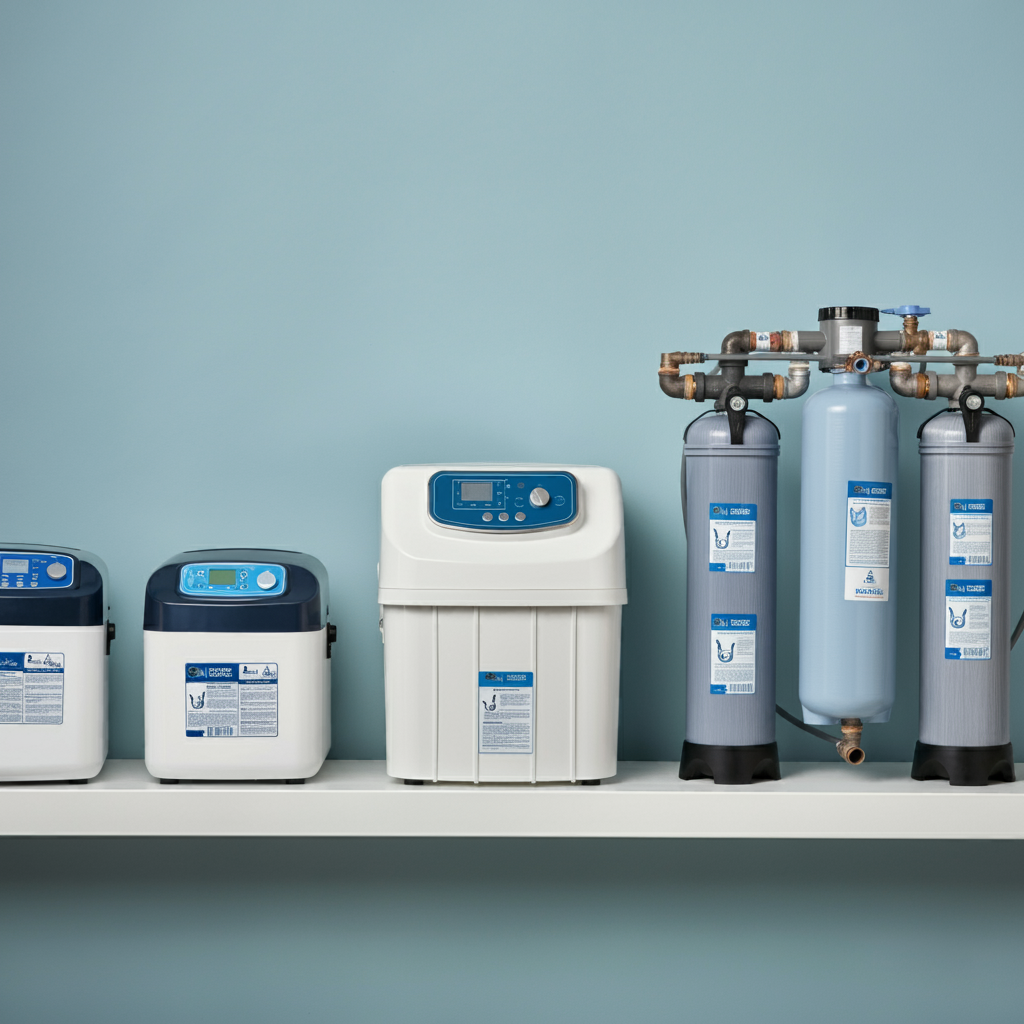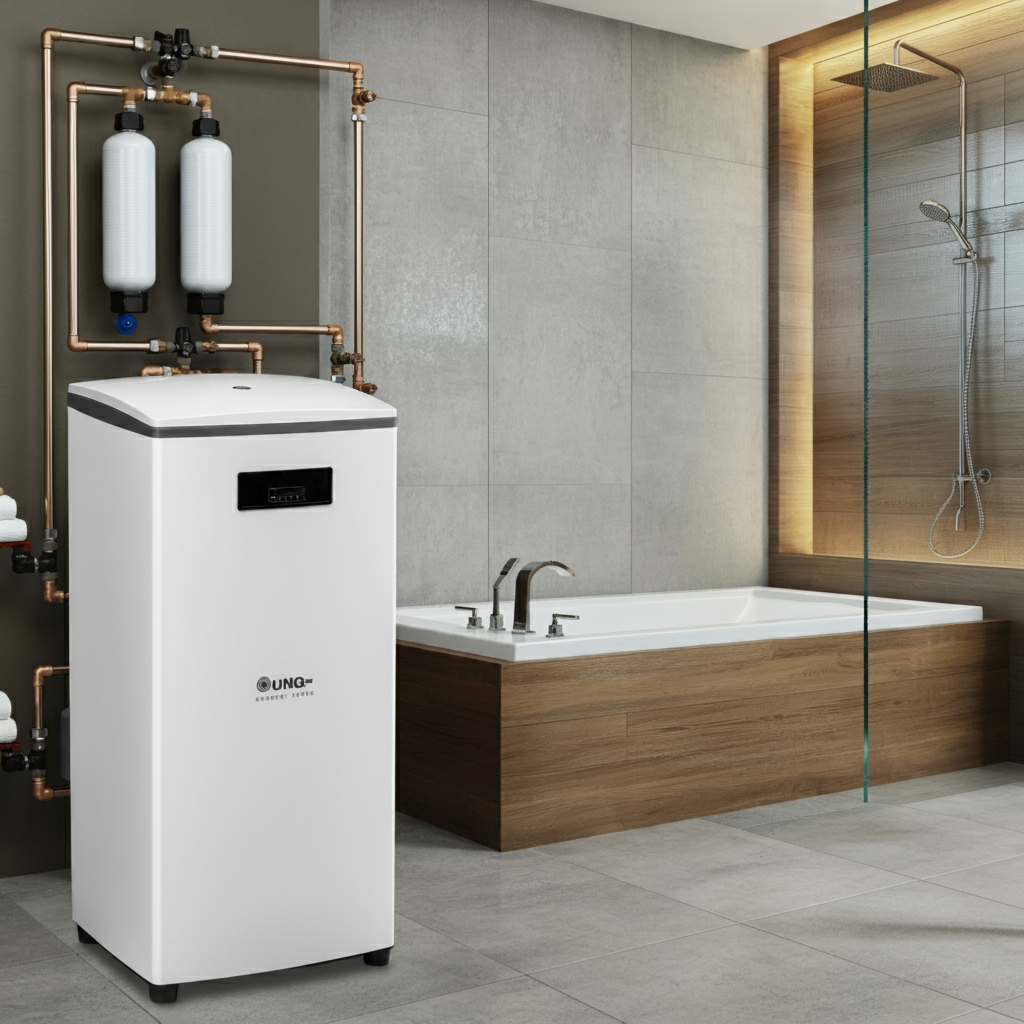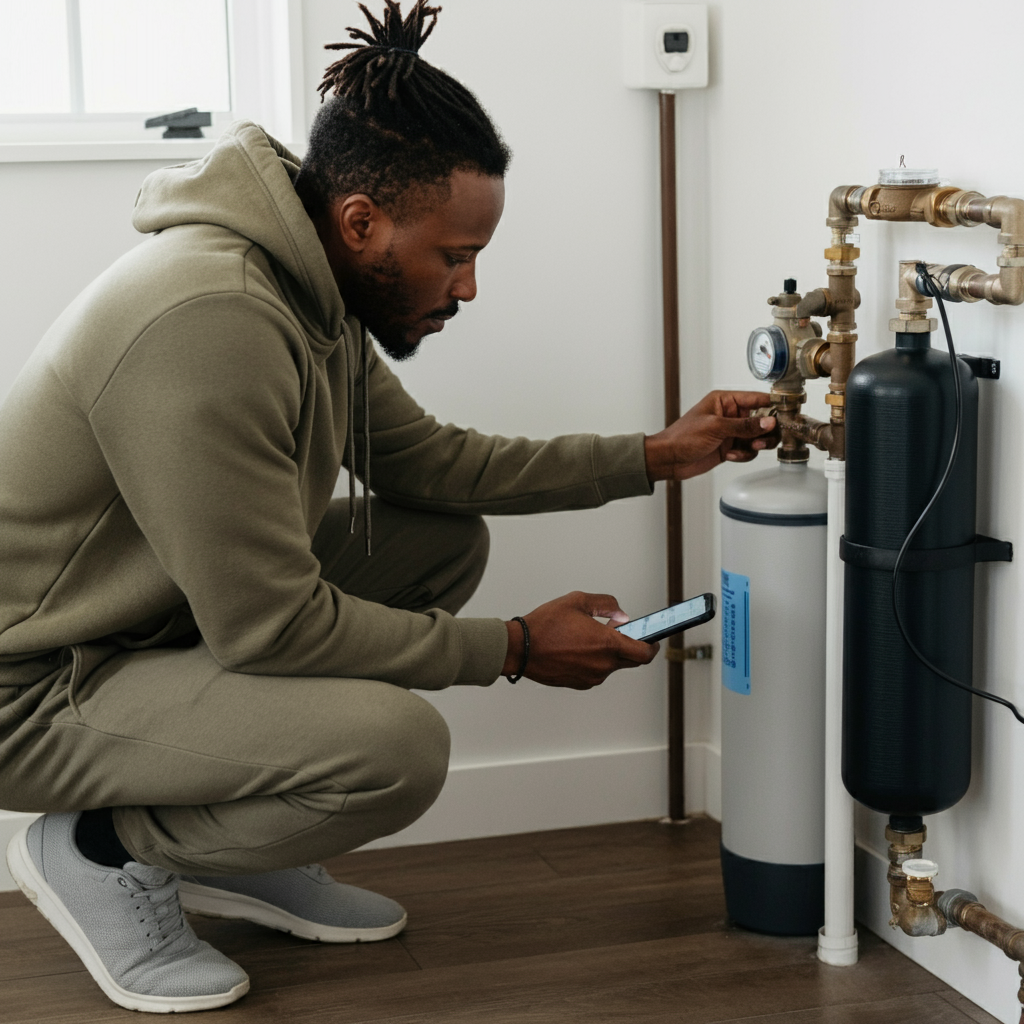To accurately size a water softener for your home, you’ll need to estimate your household’s daily water usage. This can be done in a few ways: by analyzing your water bill, using your water meter, or conducting a water audit. These methods will give you a clear picture of how much water your household consumes on average, a crucial factor in determining the right size water softener for your needs. At WaterSoftenerSizing.com, we understand that choosing the right water softener can be a daunting task. An undersized unit will regenerate too frequently, wasting salt and water, while an oversized unit is unnecessarily expensive and inefficient. By accurately estimating your daily water usage, you can ensure that your chosen water softener is perfectly tailored to your needs, providing optimal performance and longevity. Your water softener is a critical appliance that removes hardness minerals like calcium and magnesium from your water supply. These minerals can cause a variety of problems, from dry skin and hair to scale buildup in your pipes and appliances. A properly sized water softener not only addresses these issues but also contributes to the overall efficiency and longevity of your plumbing system and appliances. Before we delve into the specifics of each estimation method, it’s important to understand why accurate water usage is so crucial. Leading water softener brands like SoftPro, Culligan, Kinetico, and Fleck all emphasize the importance of proper sizing in their product literature and recommendations. Even governmental organizations like the Environmental Protection Agency (EPA), through its WaterSense program, recognize the importance of water-efficient appliances, including water softeners.
Why Accurate Water Usage Estimation Matters
Choosing the right water softener size isn’t just about convenience; it’s about maximizing efficiency and value. An undersized unit won’t be able to keep up with your household’s demand, leading to frequent regeneration cycles that waste both water and salt. On the other hand, an oversized unit might seem like a safe bet, but it comes with a higher upfront cost and operates less efficiently than necessary, potentially leading to higher energy bills. At WaterSoftenerSizing.com, we’re committed to helping you find the perfect balance. Our expert sizing calculations take the guesswork out of the process, ensuring you invest in a water softener that meets your specific needs and budget. By accurately estimating your daily water usage, you’ll be able to select a softener that:
- Regenerates optimally: A properly sized unit will regenerate only when necessary, saving you money on salt and reducing water waste.
- Removes hardness minerals effectively: This means softer skin and hair, less soap scum buildup, and longer-lasting appliances.
- Operates efficiently: The right size softener won’t consume excess energy, keeping your utility bills in check.
- Provides long-term value: A well-matched softener will last longer and require less maintenance, maximizing your investment.
To achieve these benefits, it’s essential to have a clear understanding of your household’s daily water consumption. This information allows us to recommend the ideal softener size and model, ensuring you get the most out of your water softening system. Several factors can influence your household’s water usage, including the number of people in your home, the types of appliances you use, and even the climate you live in. We’ll discuss these factors in more detail later on, but for now, let’s focus on the three primary methods for estimating your daily water consumption. Did You Know? The average American household uses about 80-100 gallons of water per person per day. However, this number can vary significantly depending on individual habits and household characteristics.
Method 1: Analyzing Your Water Bill
Your water bill is a treasure trove of information, including your household’s water consumption. Most water bills clearly state the total gallons of water used during a specific billing period, typically a month. To estimate your daily water usage, you’ll need to locate this figure and the number of days in your billing cycle.
How to Calculate Daily Water Usage from Your Bill
- Locate Total Gallons Used: Look for a line item on your bill that indicates the total water consumption for the billing period. This might be labeled as “total gallons used,” “water consumption,” or something similar.
- Find Billing Cycle Length: Check your bill for the start and end dates of the billing period. Subtract the start date from the end date to determine the number of days in the cycle.
- Calculate Daily Average: Divide the total gallons used by the number of days in the billing cycle. This will give you your average daily water usage in gallons.
Example: If your bill shows you used 12,000 gallons of water over a 30-day billing period, your average daily usage would be: 12,000 gallons / 30 days = 400 gallons per day Note: Some water bills may already provide the average daily usage directly, saving you the calculation. Important Considerations:
- Seasonal Variations: Keep in mind that your water usage might fluctuate throughout the year due to seasonal changes like lawn watering in the summer or less frequent showers in the winter.
- Lifestyle Events: Major events like having houseguests or filling a swimming pool can significantly impact your water usage for a short period.
- Bill Format: Water bills can vary in format depending on your local water utility. However, they typically include the essential information needed to calculate your daily usage.
What if I don’t have a water bill? If you’re unable to access your water bill, you can use the other methods described in this article to estimate your water usage.
Method 2: Using Your Water Meter
Your water meter, often located near your property line or in your basement, is a direct way to measure your household’s water usage. It tracks the exact amount of water flowing into your home. By taking readings at specific intervals, you can accurately determine your daily consumption. 
Types of Water Meters
There are two main types of water meters:
- Analog Meters: These have dials that resemble a clock face, with numbers indicating the amount of water used in cubic feet or gallons.
- Digital Meters: These display the water usage directly in numbers, often with a digital readout similar to an odometer.
How to Read Your Water Meter and Calculate Daily Usage
- Locate Your Water Meter: Most meters are found outdoors near the street or sidewalk, inside a concrete box marked “water meter.” Some homes might have indoor meters, typically in the basement or utility room.
- Identify the Units: Determine whether your meter measures in cubic feet or gallons. This information is usually indicated on the meter face.
- Record the Initial Reading: Write down the numbers on the meter at the beginning of the day. If your meter is analog, note the position of the dials. If it’s digital, simply record the displayed number.
- Record the Final Reading: After 24 hours, take another reading of the meter.
- Calculate Daily Usage: Subtract the initial reading from the final reading. This difference represents your household’s water usage for that day.
Example: If your initial reading is 5000 gallons and your final reading after 24 hours is 5400 gallons, your daily usage is: 5400 gallons – 5000 gallons = 400 gallons Important Note: If your meter measures in cubic feet, you’ll need to convert cubic feet to gallons. There are 7.48 gallons in one cubic foot. Digital Meter Readings: Some water utilities offer online portals where you can access your digital meter readings remotely, eliminating the need for manual checks. While reading your water meter might seem intimidating at first, it’s a straightforward process that provides accurate data on your water consumption. This information is invaluable for not only sizing your water softener but also for identifying potential leaks or areas where you can conserve water.
Method 3: Conducting a Water Audit
If you want a more detailed breakdown of your water usage, a water audit is your best bet. This involves tracking the water used by each fixture and activity in your home over a specific period, usually a day or a week.
What is a Water Audit?
A water audit is a systematic evaluation of your household’s water consumption patterns. It allows you to identify the major sources of water usage in your home, revealing opportunities for conservation and highlighting the specific needs your water softener will need to address.
How to Conduct a Water Audit
- Gather Information:
- Flow Rates: Determine the flow rate (gallons per minute) of each fixture in your home. This information can often be found on the manufacturer’s website or printed on the fixture itself. For older fixtures, you can measure the flow rate by timing how long it takes to fill a one-gallon container.
- Usage Time: Estimate how long each fixture is used per day. For example, how long do you typically shower, run the dishwasher, or water your lawn?
- Calculate Water Usage:
- Multiply the flow rate of each fixture by its usage time to determine the water used per activity.
- Add up the water usage for all activities to get your total daily household consumption.
Example: Let’s say your showerhead has a flow rate of 2.5 gallons per minute (GPM), and you shower for an average of 10 minutes per day. Your daily shower water usage would be: 2.5 GPM * 10 minutes = 25 gallons You can repeat this calculation for each water-using activity in your home to determine your total daily usage. Helpful Tools:
- Water Audit Worksheets: Several online resources and organizations, like the Alliance for Water Efficiency, offer free worksheets to help you track and calculate your water usage.
- Water Usage Calculators: Online calculators, such as those provided by the Water Footprint Network, can help you estimate water usage for various activities based on your household size and habits.
Benefits of a Water Audit:
- Pinpoint Inefficiencies: A water audit helps identify areas where you might be using more water than necessary, such as leaks or inefficient appliances.
- Tailor Softener Sizing: By understanding your specific water usage patterns, you can choose a softener that’s perfectly sized for your needs.
- Conserve Water: A water audit often reveals opportunities for reducing water consumption, which benefits both your wallet and the environment.
While a water audit might seem like a time-consuming task, it’s a worthwhile investment that can significantly impact your water softener selection and overall water management.
Factors Influencing Household Water Usage
Understanding the variables that influence your household’s water usage is key to accurately sizing your water softener. A variety of factors contribute to the total amount of water your home consumes on a daily basis. By recognizing these factors, you can better understand your own water usage patterns and make informed decisions about water conservation and softener sizing.
1. Household Size
The number of people living in your home is a major determinant of water usage. The more people you have, the more water is typically used for showers, baths, laundry, and other daily activities. The Water Research Foundation’s Residential End Uses of Water study found that a single-person household uses an average of 50.3 gallons per day, while a four-person household uses an average of 138.6 gallons per day.
2. Age of Household Members
Age can also play a role in water consumption. Children and teenagers may take longer showers or baths, while older adults might use less water overall.
3. High-Water-Use Appliances
Certain appliances, like dishwashers and washing machines, consume a significant amount of water. If you frequently use these appliances, your daily water usage will be higher than a household that hand-washes dishes or does laundry less often. Energy-efficient models, often certified by the EPA’s WaterSense program, can help reduce water consumption.
4. Outdoor Water Use
Watering your lawn, filling a swimming pool, or washing your car can drastically increase your water usage, especially during the warmer months. Consider using water-saving irrigation systems and practicing drought-resistant landscaping to minimize outdoor water consumption.
5. Climate
Climate plays a role in water usage as well. In hotter climates, people tend to shower more frequently and may use more water for outdoor activities like gardening and cooling down.
6. Water-Saving Habits
Your household’s water-saving habits significantly impact your overall consumption. Simple practices like fixing leaks, taking shorter showers, and turning off the faucet while brushing your teeth can make a big difference. At WaterSoftenerSizing.com, we encourage our customers to adopt water-saving habits as part of a holistic approach to water management. By conserving water, you not only reduce your environmental impact but also lower your water bills and potentially choose a smaller, more affordable water softener. Did You Know? According to the EPA, leaks account for nearly 10,000 gallons of wasted water in the average home every year. 
Choosing the Right Water Softener Size
Now that you’ve successfully estimated your household’s daily water usage, it’s time to translate that information into the appropriate water softener size. This step is crucial for ensuring your chosen softener can effectively handle your water demand and hardness levels, ultimately providing you with soft, high-quality water.
Understanding Water Softener Capacity
Water softeners are rated by their capacity, measured in grains. One grain represents the ability to remove one grain of hardness minerals (calcium and magnesium) from one gallon of water. To determine the right size for your needs, you’ll need to consider both your daily water usage and your water hardness level.
Calculating Required Softener Capacity
To calculate the minimum capacity your water softener needs, follow these steps:
- Daily Water Usage (Gallons): Use the figure you obtained from one of the estimation methods discussed earlier (water bill, meter reading, or water audit).
- Water Hardness (Grains per Gallon – GPG): Obtain your water hardness level from your local water utility. They typically provide this information on their website or in annual water quality reports.
- Multiply: Multiply your daily water usage in gallons by your water hardness in GPG to get your required softener capacity in grains.
Example: If your household uses 400 gallons of water per day and your water hardness level is 15 GPG, your minimum required softener capacity would be: 400 gallons * 15 GPG = 6000 grains
Choosing the Right Size
While the calculated figure represents the minimum capacity you need, it’s often recommended to choose a softener with a slightly higher capacity to accommodate potential fluctuations in water usage or changes in household size.
Consulting the Experts
At WaterSoftenerSizing.com, our team of water treatment professionals can guide you through the entire selection process. We’ll take into account your specific water hardness, daily usage, household size, and even your budget to recommend the most suitable softener models. We partner with reputable brands like SoftPro, Culligan, Kinetico, and Fleck, known for their high-quality and reliable water softeners.
Regeneration Frequency
Another factor to consider is the softener’s regeneration frequency. This is the process by which the softener flushes out the accumulated hardness minerals and recharges itself with salt. A properly sized softener will regenerate less frequently, saving you salt and water.

Craig “The Water Guy” Phillips is the founder of Quality Water Treatment (QWT) and creator of SoftPro Water Systems.
With over 30 years of experience, Craig has transformed the water treatment industry through his commitment to honest solutions, innovative technology, and customer education.
Known for rejecting high-pressure sales tactics in favor of a consultative approach, Craig leads a family-owned business that serves thousands of households nationwide.
Craig continues to drive innovation in water treatment while maintaining his mission of “transforming water for the betterment of humanity” through transparent pricing, comprehensive customer support, and genuine expertise.
When not developing new water treatment solutions, Craig creates educational content to help homeowners make informed decisions about their water quality.



May I request more information on the subject? http://www.ifashionstyles.com All of your articles are extremely useful to me. Thank you!